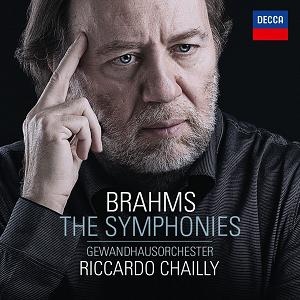
As always, there are biases at play here; my greatest interests are symphonic music, choral music, and piano music, so that's what comes my way most often. There are some paired reviews; the ranking of the second of each pair might not be the true, exact ranking, but it works better from a writing standpoint this way.
It is not easy, at this point in recording history, to match the giants of the baton in a Brahms cycle, but Chailly has done it (this is my fiftieth Brahms cycle, and I have more than another fifty Brahms Firsts, and upwards of thirty each of the other symphonies outside those cycles, so I've got some basis for comparison). Often one must choose between alacrity and clarity, but even as Chailly moves things along at a brisk pace, the Leipzig orchestra plays with such precision that everything remains crystal-clear. Similarly, there is often a tradeoff between precision and expression, but not here. Oh, it's not the effulgent expressiveness of Furtwängler, but it's plenty. And the orchestra's timbres are full and creamy yet still distinct; the winds in particular are colorful (granted, not Eastern European colorful, but far above normal German standards). And while Chailly's tempos are on the quick side, things are plenty charming where appropriate (the inner movements of the Third are especially tender); this is no Toscanini sprint, and Chailly applies some subtle but exquisite rubato. This is a Goldilocks set: just right. And though Chailly fits the four symphonies on two CDs, there's an additional disc anyway, with the usual suspects (Academic Festival Overture, Tragic Overture, Variations on a Theme by Haydn), a few less common (the Hungarian Dances and Liebeslieder Waltzes orchestrations), and some downright rare: the recording premieres of orchestrations of two Intermezzi by Paul Klengel (1854-1935) and, most crucially, the original version of Symphony No. 1's Andante. Chailly makes everything here, even the oh-so-familiar symphonies, sound fresh and new and spontaneous without resorting to gimmicks or eccentricities. Of the cycles of the stereo era, I rank this alongside my favorites by Walter, Sawallisch, Böhm, Kurt Sanderling, Mackerras, Kertesz, slightly ahead of Klemperer and the underrated Ashkenazy and Janowski, and far ahead of Karajan, Solti, etc.
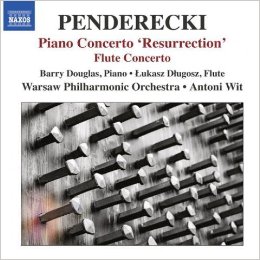 2. Barry Douglas/Lukasz Dlugosz/Warsaw Philharmonic Orchestra/Antoni Wit
2. Barry Douglas/Lukasz Dlugosz/Warsaw Philharmonic Orchestra/Antoni Wit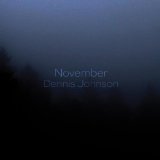 3. R. Andrew Lee
3. R. Andrew Lee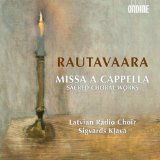 4. Latvian Radio Choir/Sigvards Klava
4. Latvian Radio Choir/Sigvards KlavaThe first recording of a major Einojuhani Rautavaara (1928- ) work is newsworthy; when it's a choral work, I start salivating. The 26-minute Missa A Cappella is, as expected, absolutely beautiful and full of interesting harmonies (much like 1940s Britten, e.g. Hymn to St. Cecilia). The premiere came in 2011, soon after its completion, but it was begun in the '70s with the Credo (1972), around which the rest was composed four decades later, not that any such break can be discerned through listening. Very gentle, often undulating, but not without a spine, it seems destined to become a 'standard' in the choir world. The other seven pieces here are more familiar; all but one were already included in Ondine's four-CD Rautavaara choral music box set (compiled last year from previously issued material), but these are different performances and, in a few cases, different arrangements by the composer. The supreme masterwork among them is the Canticum Mariae Virginis (1978), which floats magically in this recording; the Missa duodecanonica (1963), a missa brevis, shows how even when using strict 12-tone technique, Rautavaara's style is undiluted. The Latvian Radio Choir is just about perfect.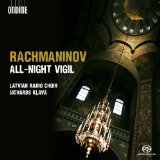
It is also a treat to hear them in Rachmaninov (as we already did on their 2010 album of his Liturgy of St. John Chrysostom). The All-Night Vigil, AKA Vespers, is by far the Russian composer's most popular choral work, and there have been a number of excellent recordings of it. Add this one to that list; the choir's blend is positively magical, and conductor Sigvards Klava shapes the music beautifully, without any quirks. A few Russian recordings edge this one out (Tchernouchenko's, Korniev's, and Polyansky's), as the LRC basses don't have quite the heft to match the Russians, but based on blend, good tempos, and excellent recorded sound, I'm ready to call Klava's the best non-Russian recording.
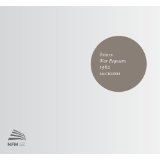 6. Susan Gritton, John Mark Ainsley, Christopher Maltman/Wroclaw Philharmonic Choir/Gabrieli Youth Singers Scheme/Trebles of the Choir of New College Oxford/Gabrieli Consort & Players/Paul McCreesh
6. Susan Gritton, John Mark Ainsley, Christopher Maltman/Wroclaw Philharmonic Choir/Gabrieli Youth Singers Scheme/Trebles of the Choir of New College Oxford/Gabrieli Consort & Players/Paul McCreeshLast year was the centenary of Benjamin Britten's birth, and what with England being one of the last countries with a thriving classical music business, there were plenty of recordings to mark the occasion. Aside from operas, this was the most ambitious; the War Requiem is not only a revered masterwork with a superb recording by the composer that competes with all subsequent renditions, it's also a massive work in scope and performing forces, not easy to coordinate or to make cohere. With conductor Paul McCreesh being an early music conductor of a revisionist bent, I wondered what tricks he might get up to here. To my delight, there are no bizarre interpretive choices, no strange tempos (contrary to my expectations, McCreesh luxuriates in the music for a couple more minutes than Britten). There is just an inspired reading that fully conveys the magic of the work. The soloists are superb; whatever one might say about relative interpretive depth, which actually I have no complaints about, this is a better-sounding and better integrated set of soloists than Britten himself had. With the vastly improved recorded sound and even more precise execution of the musical demands, this is a magnificent achievement. Maybe better than Britten's, maybe not, and certainly a composer-led performance will always have a special aura, but McCreesh and company more than hold their own and on a purely sonic level sound better, no small advantage in the complex textures and rich timbres of this music.
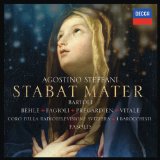 7. Cecilia Bartoli/Nuria Rial/Yetzabel Arias Fernandez/Elena Carzaniga/Franco Fagioli/Daniel Behle/Julian Pregardien/Salvo Vitale/Swiss Radio-Television Choir/I Barocchisti/Diego Fasolis
7. Cecilia Bartoli/Nuria Rial/Yetzabel Arias Fernandez/Elena Carzaniga/Franco Fagioli/Daniel Behle/Julian Pregardien/Salvo Vitale/Swiss Radio-Television Choir/I Barocchisti/Diego Fasolis
Some divas throw their weight around regarding such indulgent trivialities as the green room food, wardrobe, etc. Superstar mezzo-soprano Cecilia Bartoli, on the other hand, uses her power far more productively: she records obscure repertoire and gets the major label she's on to release it. I'll grant you that there are two other recordings of the Stabat Mater of Agostino Steffani (1654-1728) available currently, but they ain't on a major with the distribution reach and promotional clout of Decca, or featuring the star power Bartoli wields so adroitly and benevolently. After starring herself on last year's Steffani project, Mission, she has moved out of the spotlight to varying degrees on the two present Steffani discs. She is, in fact, entirely absent from the Dances and 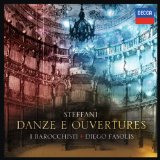 Overtures album, since it is purely instrumental. It's a great deal of fun nonetheless, and recommended to anyone who enjoys late Baroque instrumentals (such as Vivaldi fans). Fully 27 of the 43 tracks are recording premieres; 20 separate operas are heard from. The main focus, though, is of course on the Steffani album with Bartoli. Steffani's Stabat Mater is an excellent piece of its type, full of variety in the combinations of solo voices and choir. Bartoli did not shy away from hiring excellent soloists; bass Salvo Vitale in particular has a big, luscious voice (check out "Vidit suum dulcem Natum"). Of course, Bartoli's dark and vibrant tones are immediately recognizable, but she blends well enough with duet partners and always shines when in the solo spotlight. This album also includes six other sacred choral works, all taken from manuscripts and all recording premieres. They are at the same high level of compositional achievement as the Stabat Mater. All fans of Baroque sacred music should get this album.
Overtures album, since it is purely instrumental. It's a great deal of fun nonetheless, and recommended to anyone who enjoys late Baroque instrumentals (such as Vivaldi fans). Fully 27 of the 43 tracks are recording premieres; 20 separate operas are heard from. The main focus, though, is of course on the Steffani album with Bartoli. Steffani's Stabat Mater is an excellent piece of its type, full of variety in the combinations of solo voices and choir. Bartoli did not shy away from hiring excellent soloists; bass Salvo Vitale in particular has a big, luscious voice (check out "Vidit suum dulcem Natum"). Of course, Bartoli's dark and vibrant tones are immediately recognizable, but she blends well enough with duet partners and always shines when in the solo spotlight. This album also includes six other sacred choral works, all taken from manuscripts and all recording premieres. They are at the same high level of compositional achievement as the Stabat Mater. All fans of Baroque sacred music should get this album.
 9. Emanuel Ax
9. Emanuel AxThe thinking man's pianist delivers again. Rather than playing the "Eroica" Variations for pure flash and coming out gangbusters, he builds it slowly. It gives the set a more profound mien, and the arc created helps make more sense of the aching 14th and 15th Variations, which are deeply affecting in Ax's reading. The way he builds up 15 is a master class in proportion. And when there are virtuoso passages, he's more than up to them. Ax also ruminates through Haydn's innovative double-themed Variations in F minor; his astute understanding of its structure helps him make it especially poignant. In the Schumann, we are more firmly in the realm of virtuoso music, but with slower, more sheerly beautiful movements interspersed. Ax also sprinkles in three of the five additional variations that Brahms included decades after Schumann's death. (Schumann had done some pruning before publication.) Once again, Ax's keen sense of proportion makes for a memorable interpretation, and the tenderness is subtly striking. The CD ends there, but the download also includes Aaron Copland's Piano Variations, taking us into a different century and a different culture. Here Ax's pearly tone pays dividends. Pianists specializing in modern music often have a steely tone that makes this thorny music seem even more forbidding; as played by Ax, this set seems less distant from the 19th century works on the program.
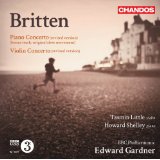 10. Tasmin Little/Howard Shelley/BBC Philharmonic/Edward Gardner
10. Tasmin Little/Howard Shelley/BBC Philharmonic/Edward Gardner
More Britten, and it's no surprise coming from the great English label Chandos, which calls on two of its stars for the solo roles. In both pieces we get the revised versions, but the Piano Concerto's original (1938) slow movement is included as a bonus track; dubbed a Recitative and Aria, it seems at times like a refugee movement from a Concerto for Orchestra, what with the prominence of various winds at different times; it also sounds rather Parisian (imagine a cross between Saint-Saens and Poulenc), sparklingly flamboyant, of drastically different character from the more staid rest of the concerto, but it works well as a stand-alone piece and gets a brilliant performance from Shelley and Gardner. Shelley's performance of the revised concerto (1945) must stand, as all do, in the shadow of Sviatoslav Richter's reading for Decca with the composer conducting, but Shelley does pretty well himself with an alternative approach, making the diffuse structure cohere and earning smiles as he fully indulges Britten's cheeky parodies of Romantic concerto tropes (Richter plays them straight). Little has more to work with in the Violin Concerto, which is far more emotive and better-written. She is even more moving than most who've played this, and sounds wonderful as well. She has a big vibrato, but she varies it enough and keeps it tight enough that it never becomes sappy even though effusive. It's a very moving performance that milks it for all it's worth, especially the somberly dramatic finale. In a year chock-full of Britten, this still stands out.
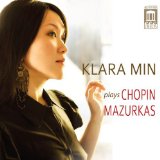 11. Klara Min
11. Klara MinThis Korean pianist, now residing in New York, approaches these little dance pieces from an unexpected perspective. Rather than emphasizing their dance rhythms and keeping them snappy, which is the norm, she lingers over them, turning each one into a voluptuous self-contained world. Which is not to say her rhythms are lax or flaccid; they're just as pointed as the competition's (check out Op. 50 No. 3). But the slower tempos allow Chopin's luscious harmonies a chance to be more fully apprehended, which is most welcome. One could not get away with converting these pieces into miniature tone poems -- which is what she seems to be doing -- without the most exquisite touch, and she certainly has that in spades, along with a combination of attention to detail and taste that keeps her readings engrossing on repeated listening. The approach is a little too unusual to make this the top recommendation for newcomers to this repertoire (they are of course directed to Arthur Rubinstein's iconic renditions), but this album's sensual charms have exerted a strong pull on me for months.
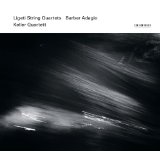 12. Keller Quartet
12. Keller QuartetThe first of Ligeti's String Quartets, "Metamorphoses nocturnes," was written in 1953-54, before he fled Hungary's Communist regime. It is an unusually structured quartet in 17 sections; technically it is one movement, but sometimes the breaks between sections are significant, and certainly the contrasts are often stark. Section styles range from Bartokian to harshly bowed swathes of dissonance to mournful elegy to sardonic vernacular bits to hushed nocturnal moments, and more. The Keller Quartet, fellow Hungarians, render the work characterfully, never curbing the astringent passages but also honoring the occasional plush areas, notably the concluding Lento. Then, in an odd but effective programming choice, comes the famous Barber Adagio, but played with a keening tone that makes this the leanest, most eerie version I've heard. I admire the chutzpah, and think it works. (But I can't help but wish that, on a 51-minute CD, they had played the entire Barber Quartet. It wouldn't provide the effect they were looking for with the way they sequenced the pieces, though.) By the time Ligeti wrote his Second Quartet, his music had become much more avant-garde (not that the First is easy listening). It proceeds through a series of musical gestures and textures, varying the material drastically according to contrasts in speed, volume, etc. The psychic turmoil that results (depiction or causation, your choice) is extremely intense. The Kellers' reading is finely nuanced and quite evocative.
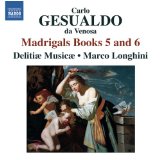 13. Delitiæ Musicæ/Marco Longhini
13. Delitiæ Musicæ/Marco LonghiniYou're hip to how innovative Carlo Gesualdo da Venosa (1566-1613) was, right? The wildest harmonies of the Renaissance, allied to agonizing texts of lost love. (Something Carlo knew a little about after finding his wife in bed with another man. After which he naturally, being a prince and all and required to defend his honor, put his sword through them both, death being the ultimate loss.) With this three-disc set, the best complete set of Gesualdo's madrigals is finished. The high quality that has been present throughout the cycle is here as well. We get excellent pitch and blend, supple and highly expressive phrasing and dynamics (without overdoing it), and appropriate milking of Gesualdo's juicy dissonances by all-male quintets (drawing from a pool of seven singers) with two fine (non-hooty) countertenors taking the high parts. Finally the old (1965) Quinetto Vocale Italiano set has been superseded. Complete texts and translations included (hardly a given nowadays).
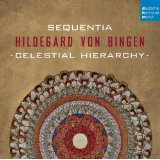 14. Sequentia
14. SequentiaAnother important early music recording project concluded triumphantly in 2013: Sequentia's recordings of the complete music of Hildegard von Bingen (1098-1179), a project over thirty years in the making and more than incidentally responsible for the greatly increased interest, in that time, in the "Sibyll of the Rhine." My review is here.
As I wrote for the Classical Ear app (classicalear.co.uk): "Recordings of this underrated work often seem tentative or merely dutiful, usually foundering immediately on the first movement, which can so easily come off as disjointed. Young seems fully committed to the work's validity and makes the first movement cohere superbly. Rather than going for maximum contrast between thematic sections, she integrates them in terms of both tempo and texture. Young takes the opposite tack in the Scherzo, luxuriating in the softer Trio, though playing the aggressive bits with emphatic force rather than speed. Her tempos, in all four movements, are on the broad side, and the orchestra's rich tone (refulgent brass in particular) and phrasing augment the effect of her conception of the work. It helps that this concert recording offers full-bodied yet detailed and well-balanced SACD sound (stereo/multichannel hybrid). Thanks to Young's more aptly Brucknerian tempo proportions, 'Die Nullte' finally sounds like a work of gravity and stature."
Madrigal connoisseurs know that it was Luca Marenzio (c.1553-1599), not peers now more famous, who was considered the top madrigalist of his time (he was an undeniable influence on Monteverdi). He produced a whopping 24 madrigal collections, of which this, in 1580, was the first. La Compagnia del Madrigale is a new group unfamiliar to me, consisting of three male and three female singers. I almost set this disc aside on hearing some ugly sounds, but then I checked the lyrics of "Dolorosi martir, fieri tormenti": "Bitter agonies, fierce torments, harsh traps, cruel snares, rasping chains, whilst I lament my lost love wretchedly." (Luigi Tansillo is the poet, channeling Dante's Inferno.) So there was justification, and it is not overdone. "Dolorosi martir, fieri tormenti" is striking not just for the vocal timbres, but for its dissonant harmonies, advanced for that time. All the madrigals in Book I are for five voices except the last of the 14, an echo piece for two quartets (two additional singers join for that one). After that there is room for the inclusion of works from a multi-composer collection of 1582, Dolci affeti, from which we hear another Marenzio madrigal plus a collaborative Sestina (movements by Nanino, Moscaglia, Marenzio, de Macque, Soriano, and Zoilo). Finally, there is a reconstruction of Marenzio's earliest known madrigal, from a 1577 collection. This is an excellent album recommended to all madrigal fans; I eagerly await further releases from La Compagnia del Madrigale, and dream of a Marenzio cycle from them.
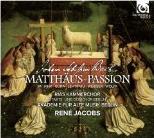 17. Sunhae Im/Christina Roterberg/Bernarda Fink/Marie-Claude Chappuis/Werner Güra (Evangelist)/Topi Lehtipuu/Fabio Trümpy/Johannes Weisser (Christ)/Konstantin Wolff/Arttu Kataja/RIAS Kammerchor/Staats- & Domchor Berlin/Akademie für Alte Musik Berlin/René Jacobs
17. Sunhae Im/Christina Roterberg/Bernarda Fink/Marie-Claude Chappuis/Werner Güra (Evangelist)/Topi Lehtipuu/Fabio Trümpy/Johannes Weisser (Christ)/Konstantin Wolff/Arttu Kataja/RIAS Kammerchor/Staats- & Domchor Berlin/Akademie für Alte Musik Berlin/René JacobsIt's hard to believe it's taken this long for a Jacobs recording of the St. Matthew to appear (well, as a conductor; he's a singer on Herreweghe's first, and Leonhardt's). "Worth the wait" definitely applies here, not least because of the unique perspective of this recording. And that's not metaphorical: this recreates the division of forces as heard at St. Thomas's in Leipzig, with Choir 1 and its accompanying orchestra in front of the congregation and the smaller Choir 2 with its own small orchestra in the back balcony. Even on my normal stereo system, the spaciousness and spatiality of this arrangement comes through; on an SACD system, I imagine the effect is stronger and more realistic. But this recording matters much more than that aspect alone. This is a majestic performance. Some have faulted the period performance movement, which Jacobs is unabashedly a part of, for removing much of the majesty that used to be commonplace in Bach performances; one cannot complain of that with this recording. This is a strongly reverential reading that lingers occasionally, though with enough rhythmic lilt that it never lumbers like some pre-PP recordings did. Nor does Jacobs skimp on other Baroque performance aspects. For instance, in the wonderful bass aria "Mache dich, mein Herze, rein," Wolff ornaments and varies the melody in the da capo section. The soloists are excellent, with many of them familiar from other Bach recordings; Güra is an especially expressive Evangelist. The choir, organist, and period orchestra produce rich tones (no one-on-a-part here), and Jacobs gives us a characterful interpretation.
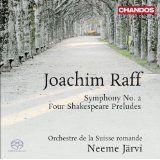 18. Orchestre de la Suisse Romande/Neeme Jarvi
18. Orchestre de la Suisse Romande/Neeme JarviProlific but underrated composer Joachim Raff (1822-1882) is little remembered now, but he was a master symphonist, as can be heard on this fine new recording. Fans of Austro-Germanic Romanticism are particularly recommended to give him a listen and take the opportunity to acquaint themselves with this unjustly denigrated contemporary of Brahms. Review here.
 19. Trinity Wall Street Choir/Tarab Cello Ensemble/Alarm Will Sound
19. Trinity Wall Street Choir/Tarab Cello Ensemble/Alarm Will Sound 20. Maurizio Pollini
20. Maurizio PolliniRecorded the year (2012) this Italian maestro of the keys turned 70, this is a successful continuation of one of the most slowly accreting Beethoven sonata cycles in history (38 years so far, with another four to go; he's recorded some twice, studio and concert). Pollini is not quite the flawless technician he used to be -- his steely rhythmic precision has gone ever so slightly fuzzy, so some of the busier passages in 4 and 11 are a tad elided -- but his touch and phrasing make Beethoven's lines sound like strings of beautifully shining pearls. And, touch being the aspect of pianistic technique that's too much underappreciated and underutilized nowadays, there is much the most hot-shot young pianists could learn from listening to this album. Equally welcome is that interpretively, there is never an exaggeration nor eccentricity, yet neither is there a rote nor bland moment to be heard. Of course, two of these sonatas (4 and 11) rank among Beethoven's masterpieces. But Pollini gives just as fully of his mastery in the pair of littler sonatas that make up Op. 14. In his hands they seem nobler, yet there is no sense of them being inflated beyond their merits or proper proportions. And proportion is one of the secrets of Pollini's mastery. His tempos seem perfectly judged, with, again, nothing odd straining for attention or novelty. There is a sense of inevitable and utterly graceful (yet smoothly powerful) rightness to the overall direction of these performances, with a warmth and poetry not always present in his earlier Beethoven recordings.

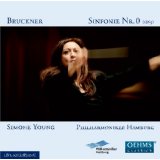 15.
15. 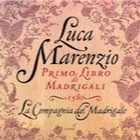 16.
16.